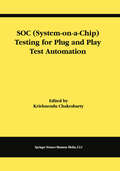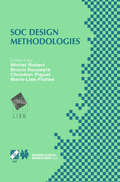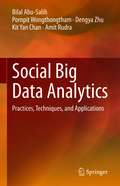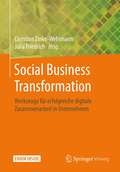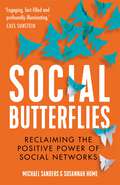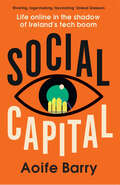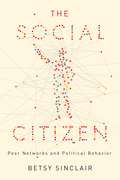- Table View
- List View
So werden wir lernen!: Kompetenzentwicklung in einer Welt fühlender Computer, kluger Wolken und sinnsuchender Netze
by John Erpenbeck Werner SauterWie werden wir in zehn Jahren beruflich - betrieblich lernen? In welcher Weise werden wir dann die vielfältigen neuen Möglichkeiten der Lerntechnologie und des sozialen Lernens im Web nutzen, die sich schon heute andeuten? In den kommenden zehn Jahren werden Computer zu aktiven Lernpartnern, die Kompetenzentwicklungsprozesse ermöglichen und tutoriell begleiten. Dabei sind drei Trends von wesentlicher Bedeutung: • Die Entfaltung semantischer Netze im Rahmen von Kompetenzentwicklungsprozessen,• die zunehmende Einbeziehung des Cloud Computing in betriebliche Lernsysteme,• die Nutzung immer leistungsfähigerer „humanoider“ Computer als Tandempartner beim selbstorganisierten Kompetenzaufbau. Die Autoren analysieren diese Entwicklungen. Sie leiten Trends für das Lernen in der Zukunft ab und entwickeln Anwendungsvorschläge für die Kompetenzentwicklung mit dem „Lernpartner Computer“. Sie prognostizieren, wie sich Lernräume und Lernkulturen in Unternehmen schrittweise auf diese kommenden Veränderungen hin entwickeln werden und leiten daraus konkrete Handlungsempfehlungen für die Gestaltung der aktuellen Lernsysteme ab.
SOA?: Serviceorientierung in Business und Software (Xpert.press)
by Dieter MasakServiceorientierte Architektur, kurz SOA, das Zauberwort in modernen Unternehmen: Durch SOA hoffen Manager, dass Firmen flexibler, agiler, einfach schneller und unmittelbar auf Kundenwünsche eingehen können. Der Autor zeigt v.a. die Auswirkungen der Serviceorientierung auf Softwareentwicklung, Organisation und Prozesse. Denn die Einführung einer SOA hat massive Auswirkungen auf alle Teile eines Unternehmens und seine Wertschöpfungskette. Mittelfristig erfordert sie neue Kooperations- und Kommunikationsformen. Plus: die Grenzen von Services aus systemtheoretischer Sicht sowie mögliche Lösungen für sehr große Systeme und mobile Anwendungen.
SOA and Web Services Interface Design: Principles, Techniques, and Standards (The MK/OMG Press)
by James BeanIn SOA and Web Services Interface Design, data architecture guru James Bean teaches you how to design web service interfaces that are capable of being extended to accommodate ever changing business needs and promote incorporation simplicity. The book first provides an overview of critical SOA principles, thereby offering a basic conceptual summary. It then provides explicit, tactical, and real-world techniques for ensuring compliance with these principles. Using a focused, tutorial-based approach the book provides working syntactical examples - described by Web services standards such as XML, XML Schemas, WSDL and SOAP - that can be used to directly implement interface design procedures, thus allowing you immediately generate value from your efforts. In summary, SOA and Web Services Interface Design provides the basic theory, but also design techniques and very specific implementable encoded interface examples that can be immediately employed in your work, making it an invaluable practical guide to any practitioner in today's exploding Web-based service market. - Provides chapters on topics of introductory WSDL syntax and XML Schema syntax, taking take the reader through fundamental concepts and into deeper techniques and allowing them to quickly climb the learning curve. - Provides working syntactical examples - described by Web services standards such as XML, XML Schemas, WSDL and SOAP - that can be used to directly implement interface design procedures. - Real-world examples generated using the Altova XML Spy tooling reinforce applicability, allowing you to immediately generate value from their efforts.
SOA and WS-BPEL: Composing Service-oriented Solutions With Php And Activebpel
by Yuli VasilievWith the help of many examples, the book explains how to build Web Services with PHP, combine them into SOAs with WS-BPEL, and then deploy composite WS-BPEL-based solutions to the ActiveBPEL engine. The examples in this book are presented in a way that anyone can understand and apply. This book is suitable for anyone who wants to start building SOA applications using powerful tools available free of charge. It also will be useful for PHP developers willing to move towards Service-Oriented Architecture (SOA). Readers need only a basic knowledge of SOA, BPEL, and Web Services; even a total beginner will be able to follow the examples, provided the required software components are installed on his or her computer. More experienced readers might use this book as a reference, focusing only on the chapters of interest.
SOA Approach to Integration: Xml, Web Services, Esb, And Bpel In Real-world Soa Projects
by Frank Jennings Matjaz B. Juric Poornachandra SarangAfter explaining the challenges, levels, and strategies of integration the book explains SOA, web services, and the Enterprise Services Bus before covering processing XML and web services on the .Net and JEE platforms in more detail. Then it covers BEPL and demonstrates service composition into business processes with a realistic, although simple example BPEL process. Finally it shows how ESB provides a concrete infrastructure for SOA. This book is for architects and senior developers who are responsible for setting up SOA for integration for applications within the enterprise (intra-enterprise integration) and applications across enterprises (inter-enterprise integration or B2B).
SoapUI Cookbook
by Rupert AndersonThis book is aimed at developers and technical testers who are looking for a quick way to take their SoapUI skills and understanding to the next level. Even if you are new to SoapUI but have basic Java skills and a reasonable grasp of RESTFul and Soap web services, then you should have no problem making use of this book.
Soar: A Tribute to Allen Newell (Studies in Cognitive Systems #10)
by AladinAkyürek John A. MichonSoar: A Cognitive Architecture in Perspective represents a European perspective on Soar with the exception of the special contribution from Allen Newell arguing for Unified Theories of Cognition. The various papers derive from the work of the Soar Research Group that has been active at the University of Groningen, The Netherlands, since 1987. The work reported here has been inspired in particular by two topics that precipitated the group's interest in Soar in the first place -- road user behavior and the temporal organization of behavior, more specifically planning. At the same time, the various contributions go well beyond the simple use of Soar as a convenient medium for modeling human cognitive activity. In every paper one or more fundamental issues are raised that touch upon the very nature and consistency of Soar as an intelligent architecture. As a result the reader will learn about the operator implementation problem, chunking, multitasking, the need to constrain the depth of the goal stack, and induction, etc. Soar is still at a relatively early stage of development. It does, nevertheless, constitute an important breakthrough in the area of computer architectures for general intelligence. Soar shows one important direction that future efforts to build intelligent systems should take if they aim for a comprehensive, and psychologically meaningful, theory of cognition. This is argued in a powerful way by Newell in his contribution to this volume. For this reason, the Soar system will probably play an important integrative role within cognitive science in bringing together important subdomains of psychology, computer science, linguistics, and the neurosciences. Although Soar is not the only `architecture for intelligence', it is one of the most advanced and theoretically best motivated architectures presently available. Soar: A Cognitive Architecture in Perspective is of special interest to researchers in the domains of cognitive science, computer science and artificial intelligence, cognitive psychology, and the philosophy of mind.
Soar with Haskell: The ultimate beginners' guide to mastering functional programming from the ground up
by Tom SchrijversBuild powerful software solutions and develop proficiency in Haskell, from understanding the foundational principles through to mastering advanced functional programming conceptsKey FeaturesLearn from an expert lecturer and researcher who knows all the ins and outs of HaskellDevelop a clear understanding of Haskell, from the basics through to advanced conceptsGet to grips with all the key functional programming techniquesPurchase of the print or Kindle book includes a free PDF eBookBook DescriptionWith software systems reaching new levels of complexity and programmers aiming for the highest productivity levels, software developers and language designers are turning toward functional programming because of its powerful and mature abstraction mechanisms. This book will help you tap into this approach with Haskell, the programming language that has been leading the way in pure functional programming for over three decades. The book begins by helping you get to grips with basic functions and algebraic datatypes, and gradually adds abstraction mechanisms and other powerful language features. Next, you’ll explore recursion, formulate higher-order functions as reusable templates, and get the job done with laziness. As you advance, you’ll learn how Haskell reconciliates its purity with the practical need for side effects and comes out stronger with a rich hierarchy of abstractions, such as functors, applicative functors, and monads. Finally, you’ll understand how all these elements are combined in the design and implementation of custom domain-specific languages for tackling practical problems such as parsing, as well as the revolutionary functional technique of property-based testing. By the end of this book, you’ll have mastered the key concepts of functional programming and be able to develop idiomatic Haskell solutions.What you will learnWrite pure functions in all their forms – that is basic, recursive, and higher-order functionsModel your data using algebraic datatypesMaster Haskell’s powerful type-class mechanism for ad hoc overloadingFind out how Haskell’s laziness gets the job doneReconcile Haskell’s functional purity with side effectsFamiliarize yourself with the functor, applicative functor, monad hierarchyDiscover how to solve problems with domain-specific languagesFind more bugs with Haskell’s property-based testing approachWho this book is forIf you are a programmer looking to gain knowledge of Haskell who’s never been properly introduced to functional programming, this book is for you. Basic experience with programming in a non-functional language is a prerequisite. This book also serves as an excellent guide for programmers with limited exposure to Haskell who want to deepen their understanding and foray further into the language.
SOC (Frontiers in Electronic Testing #21)
by Krishnendu ChakrabartySystem-on-a-Chip (SOC) integrated circuits composed of embedded cores are now commonplace. Nevertheless, there remain several roadblocks to rapid and efficient system integration. Test development is seen as a major bottleneck in SOC design and manufacturing capabilities. Testing SOCs is especially challenging in the absence of standardized test structures, test automation tools, and test protocols. In addition, long interconnects, high density, and high-speed designs lead to new types of faults involving crosstalk and signal integrity. SOC (System-on-a-Chip) Testing for Plug and Play Test Automation is an edited work containing thirteen contributions that address various aspects of SOC testing. SOC (System-on-a-Chip) Testing for Plug and Play Test Automation is a valuable reference for researchers and students interested in various aspects of SOC testing.
SOC Design Methodologies: IFIP TC10 / WG10.5 Eleventh International Conference on Very Large Scale Integration of Systems-on-Chip (VLSI-SOC’01) December 3–5, 2001, Montpellier, France (IFIP Advances in Information and Communication Technology #90)
by Michel Robert Bruno Rouzeyre Christian Piguet Marie-Lise FlottesThe 11 th IFIP International Conference on Very Large Scale Integration, in Montpellier, France, December 3-5,2001, was a great success. The main focus was about IP Cores, Circuits and System Designs & Applications as well as SOC Design Methods and CAD. This book contains the best papers (39 among 70) that have been presented during the conference. Those papers deal with all aspects of importance for the design of the current and future integrated systems. System on Chip (SOC) design is today a big challenge for designers, as a SOC may contain very different blocks, such as microcontrollers, DSPs, memories including embedded DRAM, analog, FPGA, RF front-ends for wireless communications and integrated sensors. The complete design of such chips, in very deep submicron technologies down to 0.13 mm, with several hundreds of millions of transistors, supplied at less than 1 Volt, is a very challenging task if design, verification, debug and industrial test are considered. The microelectronic revolution is fascinating; 55 years ago, in late 1947, the transistor was invented, and everybody knows that it was by William Shockley, John Bardeen and Walter H. Brattein, Bell Telephone Laboratories, which received the Nobel Prize in Physics in 1956. Probably, everybody thinks that it was recognized immediately as a major invention.
Social and Emotional Learning and Complex Skills Assessment: An Inclusive Learning Analytics Perspective (Advances in Analytics for Learning and Teaching)
by Yuan ‘Elle’ Wang Srećko Joksimović Maria Ofelia Z. San Pedro Jason D. Way John WhitmerIn this book, we primarily focus on studies that provide objective, unobtrusive, and innovative measures (e.g., indirect measures, content analysis, or analysis of trace data) of SEL skills (e.g., collaboration, creativity, persistence), relying primarily on learning analytics methods and approaches that would potentially allow for expanding the assessment of SEL skills and competencies at scale. What makes the position of learning analytics pivotal in this endeavor to redefine measurement of SEL skills are constant changes and advancements in learning environments and the quality and quantity of data collected about learners and the process of learning. Contemporary learning environments that utilize virtual and augmented reality to enhance learning opportunities accommodate for designing tasks and activities that allow learners to elicit behaviors (either in face-to-face or online context) not being captured in traditional educational settings. Novel insights provided in the book span across diverse types of learning contexts and learner populations. Specifically, the book addresses relevant and emerging theories and frameworks (in various disciplines such as education, psychology, or workforce) that inform assessments of SEL skills and competencies. In so doing, the book maps the landscape of the novel learning analytics methods and approaches, along with their application in the SEL assessment for K-12 learners as well as adult learners. Critical to the notion of the SEL assessment are data sources. In that sense, the book outlines where and how data related to learners' 21st century skills and competencies can be measured and collected. Linking theory to data, the book further discusses tools and methods that are being used to operationalize SEL and link relevant skills and competencies with cognitive assessment. Finally, the book addresses aspects of generalizability and applicability, showing promising approaches for translating research findings into actionable insights that would inform various stakeholders (e.g., learners, instructors, administrators, policy makers).
Social Big Data Analytics: Practices, Techniques, and Applications
by Bilal Abu-Salih Pornpit Wongthongtham Dengya Zhu Kit Yan Chan Amit RudraThis book focuses on data and how modern business firms use social data, specifically Online Social Networks (OSNs) incorporated as part of the infrastructure for a number of emerging applications such as personalized recommendation systems, opinion analysis, expertise retrieval, and computational advertising. This book identifies how in such applications, social data offers a plethora of benefits to enhance the decision making process.This book highlights that business intelligence applications are more focused on structured data; however, in order to understand and analyse the social big data, there is a need to aggregate data from various sources and to present it in a plausible format. Big Social Data (BSD) exhibit all the typical properties of big data: wide physical distribution, diversity of formats, non-standard data models, independently-managed and heterogeneous semantics but even further valuable with marketing opportunities.The book provides a review of the current state-of-the-art approaches for big social data analytics as well as to present dissimilar methods to infer value from social data. The book further examines several areas of research that benefits from the propagation of the social data. In particular, the book presents various technical approaches that produce data analytics capable of handling big data features and effective in filtering out unsolicited data and inferring a value. These approaches comprise advanced technical solutions able to capture huge amounts of generated data, scrutinise the collected data to eliminate unwanted data, measure the quality of the inferred data, and transform the amended data for further data analysis. Furthermore, the book presents solutions to derive knowledge and sentiments from BSD and to provide social data classification and prediction. The approaches in this book also incorporate several technologies such as semantic discovery, sentiment analysis, affective computing and machine learning.This book has additional special feature enriched with numerous illustrations such as tables, graphs and charts incorporating advanced visualisation tools in accessible an attractive display.
Social Big Data Mining
by Hiroshi IshikawaThis book focuses on the basic concepts and the related technologies of data mining for social medial. Topics include: big data and social data, data mining for making a hypothesis, multivariate analysis for verifying the hypothesis, web mining and media mining, natural language processing, social big data applications, and scalability. It explains
Social Business Models in the Digital Economy: New Concepts and Contemporary Challenges
by Adam Jabłoński Marek JabłońskiFilling a gap in the current literature, this book addresses the social approach to the design and use of innovative business models in the digital economy. It focuses on three areas that are of increasing importance to businesses and industry today: social issues and sustainability; digitization; and new economic business models, specifically the sharing and circular economies. The authors aim to solve current scientific concerns around the conceptualization and operationalization of social business models, addressing management intentions and the impact of these models on society. Based on observation of social phenomena and the authors' research and practical experience, the book highlights best practices for designing and assessing social business models.
Social Business Transformation: Werkzeuge für erfolgreiche digitale Zusammenarbeit in Unternehmen
by Christian Zinke-Wehlmann Julia FriedrichDie Zukunft der Arbeit verlagert sich zunehmend in den digitalen Raum. Deutsche Unternehmen positionieren sich in der Gestaltung dieses Raumes bislang häufig in der Rolle der Nachzügler, weil sie die Bedeutung des Einsatzes sozialer Technologien (z.B. Enterprise Social Networks) für das Unternehmen unterschätzen. Das resultierende Risiko im globalen Wettbewerb unterzugehen, ist gerade für den Mittelstand erheblich.Um zukunftsfähige Wege einzuschlagen, braucht es neue Gestaltungsansätze. Einer davon ist Social Business. Social Business wird im vorliegenden Werk als ganzheitliches Konzept beschrieben, welches durch den systematischen Einsatz digitaler und kollaborativer Werkzeuge neue Möglichkeiten der Innovation und Wertschöpfung schafft. Soziale Technologien ermöglichen eine proaktive Gestaltung unternehmensinterner und -übergreifender Prozesse und bieten insbesondere im Wissensmanagement, in der Kommunikation sowie der Zusammenarbeit produktionssteigernde Potenziale.Im Rahmen dieses Werkes werden praktische Anwendungen, Konzepte zur Umsetzung von Social Business und Leitlinien für den Transformationsprozess wissenschaftlich fundiert und praxisnah präsentiert.
Social Butterflies: Reclaiming the Positive Power of Social Networks
by Michael Sanders Susannah Hume'Engaging, fact-filled and profoundly illuminating. It's inspiring to read – and it should help make the world a lot better.' Cass Sunstein, author of NudgeThe rise of social media has sent our social instincts into overdrive, and the impact of our networks has never been greater. But what if we could reclaim the positive power that influences our decisions, to behave better and be happier? In this groundbreaking book, Sanders and Hume build on the incredible findings of their own cutting-edge research from their work at the world’s first Nudge Unit, as well as illuminating case studies from experts around the world, to show how small changes in our environments can have a huge impact on where our instincts lead us. At a time when our trust in each other is being destroyed on a global scale, it’s never been more important to understand what motivates us and how to use our predictable behaviours to drive positive change. From helping us to run more cohesive organizations, to building important relationships and connections that matter, this is an essential roadmap back to our better social selves.
Social Capital: Life online in the shadow of Ireland’s tech boom
by Aoife BarryA David and Goliath story about Ireland’s role as prime real estate for the world’s largest tech multinationals, and the considerable impact it has had on us as individuals.
The Social CEO: How Social Media Can Make You A Stronger Leader
by Damian CorbetThere remains a huge gulf in understanding by many leaders of what some are calling the Social Age – huge changes going on in society, enabling anyone with a smartphone to sign up to a social network and comment on anything and everything. Despite this revolution, which has been embraced by the masses, it is the people at the top of organizations who have been slowest to understand and adapt to it.While business leaders may feel that it's enough to hire social media managers and amend their marketing strategies, Damian Corbet shows why organizations need to do more to succeed in the Social Age – why CEOs need to 'get social' to survive. The Social CEO sets out to educate and inspire senior leaders to embrace the Social Age, teaching them the hows and whys of utilising social media in order to make them stronger leaders. Social CEOs can effectively encourage engagement from their employees as well as other stakeholders and customers; they're better able to communicate their organization's objectives and values, gauge the climate in which they operate and improve their brand image.Offering invaluable contributions from industry-recognised experts in social business, The Social CEO explores the many aspects of leading in the Social Age, such as storytelling, personal branding, managing risk and public relations. With chapters also written by practising 'social CEOs' working across a variety of sectors, from healthcare to sport, the book provides a wealth of insight into how social media can be used to gain a competitive advantage.
The Social CEO: How Social Media Can Make You A Stronger Leader
by Damian CorbetThere remains a huge gulf in understanding by many leaders of what some are calling the Social Age – huge changes going on in society, enabling anyone with a smartphone to sign up to a social network and comment on anything and everything. Despite this revolution, which has been embraced by the masses, it is the people at the top of organizations who have been slowest to understand and adapt to it.While business leaders may feel that it's enough to hire social media managers and amend their marketing strategies, Damian Corbet shows why organizations need to do more to succeed in the Social Age – why CEOs need to 'get social' to survive. The Social CEO sets out to educate and inspire senior leaders to embrace the Social Age, teaching them the hows and whys of utilising social media in order to make them stronger leaders. Social CEOs can effectively encourage engagement from their employees as well as other stakeholders and customers; they're better able to communicate their organization's objectives and values, gauge the climate in which they operate and improve their brand image.Offering invaluable contributions from industry-recognised experts in social business, The Social CEO explores the many aspects of leading in the Social Age, such as storytelling, personal branding, managing risk and public relations. With chapters also written by practising 'social CEOs' working across a variety of sectors, from healthcare to sport, the book provides a wealth of insight into how social media can be used to gain a competitive advantage.
The Social Citizen: Peer Networks and Political Behavior (Chicago Studies in American Politics)
by Betsy SinclairHuman beings are social animals. Yet despite vast amounts of research into political decision making, very little attention has been devoted to its social dimensions. In political science, social relationships are generally thought of as mere sources of information, rather than active influences on one’s political decisions. Drawing upon data from settings as diverse as South Los Angeles and Chicago’s wealthy North Shore, Betsy Sinclair shows that social networks do not merely inform citizen’s behavior, they can—and do—have the power to change it. From the decision to donate money to a campaign or vote for a particular candidate to declaring oneself a Democrat or Republican, basic political acts are surprisingly subject to social pressures. When members of a social network express a particular political opinion or belief, Sinclair shows, others notice and conform, particularly if their conformity is likely to be highly visible. We are not just social animals, but social citizens whose political choices are significantly shaped by peer influence. The Social Citizen has important implications for our concept of democratic participation and will force political scientists to revise their notion of voters as socially isolated decision makers.
The Social Citizen: Peer Networks and Political Behavior (Chicago Studies in American Politics)
by Betsy SinclairHuman beings are social animals. Yet despite vast amounts of research into political decision making, very little attention has been devoted to its social dimensions. In political science, social relationships are generally thought of as mere sources of information, rather than active influences on one’s political decisions. Drawing upon data from settings as diverse as South Los Angeles and Chicago’s wealthy North Shore, Betsy Sinclair shows that social networks do not merely inform citizen’s behavior, they can—and do—have the power to change it. From the decision to donate money to a campaign or vote for a particular candidate to declaring oneself a Democrat or Republican, basic political acts are surprisingly subject to social pressures. When members of a social network express a particular political opinion or belief, Sinclair shows, others notice and conform, particularly if their conformity is likely to be highly visible. We are not just social animals, but social citizens whose political choices are significantly shaped by peer influence. The Social Citizen has important implications for our concept of democratic participation and will force political scientists to revise their notion of voters as socially isolated decision makers.
The Social Citizen: Peer Networks and Political Behavior (Chicago Studies in American Politics)
by Betsy SinclairHuman beings are social animals. Yet despite vast amounts of research into political decision making, very little attention has been devoted to its social dimensions. In political science, social relationships are generally thought of as mere sources of information, rather than active influences on one’s political decisions. Drawing upon data from settings as diverse as South Los Angeles and Chicago’s wealthy North Shore, Betsy Sinclair shows that social networks do not merely inform citizen’s behavior, they can—and do—have the power to change it. From the decision to donate money to a campaign or vote for a particular candidate to declaring oneself a Democrat or Republican, basic political acts are surprisingly subject to social pressures. When members of a social network express a particular political opinion or belief, Sinclair shows, others notice and conform, particularly if their conformity is likely to be highly visible. We are not just social animals, but social citizens whose political choices are significantly shaped by peer influence. The Social Citizen has important implications for our concept of democratic participation and will force political scientists to revise their notion of voters as socially isolated decision makers.
The Social Citizen: Peer Networks and Political Behavior (Chicago Studies in American Politics)
by Betsy SinclairHuman beings are social animals. Yet despite vast amounts of research into political decision making, very little attention has been devoted to its social dimensions. In political science, social relationships are generally thought of as mere sources of information, rather than active influences on one’s political decisions. Drawing upon data from settings as diverse as South Los Angeles and Chicago’s wealthy North Shore, Betsy Sinclair shows that social networks do not merely inform citizen’s behavior, they can—and do—have the power to change it. From the decision to donate money to a campaign or vote for a particular candidate to declaring oneself a Democrat or Republican, basic political acts are surprisingly subject to social pressures. When members of a social network express a particular political opinion or belief, Sinclair shows, others notice and conform, particularly if their conformity is likely to be highly visible. We are not just social animals, but social citizens whose political choices are significantly shaped by peer influence. The Social Citizen has important implications for our concept of democratic participation and will force political scientists to revise their notion of voters as socially isolated decision makers.
The Social Citizen: Peer Networks and Political Behavior (Chicago Studies in American Politics)
by Betsy SinclairHuman beings are social animals. Yet despite vast amounts of research into political decision making, very little attention has been devoted to its social dimensions. In political science, social relationships are generally thought of as mere sources of information, rather than active influences on one’s political decisions. Drawing upon data from settings as diverse as South Los Angeles and Chicago’s wealthy North Shore, Betsy Sinclair shows that social networks do not merely inform citizen’s behavior, they can—and do—have the power to change it. From the decision to donate money to a campaign or vote for a particular candidate to declaring oneself a Democrat or Republican, basic political acts are surprisingly subject to social pressures. When members of a social network express a particular political opinion or belief, Sinclair shows, others notice and conform, particularly if their conformity is likely to be highly visible. We are not just social animals, but social citizens whose political choices are significantly shaped by peer influence. The Social Citizen has important implications for our concept of democratic participation and will force political scientists to revise their notion of voters as socially isolated decision makers.
The Social Citizen: Peer Networks and Political Behavior (Chicago Studies in American Politics)
by Betsy SinclairHuman beings are social animals. Yet despite vast amounts of research into political decision making, very little attention has been devoted to its social dimensions. In political science, social relationships are generally thought of as mere sources of information, rather than active influences on one’s political decisions. Drawing upon data from settings as diverse as South Los Angeles and Chicago’s wealthy North Shore, Betsy Sinclair shows that social networks do not merely inform citizen’s behavior, they can—and do—have the power to change it. From the decision to donate money to a campaign or vote for a particular candidate to declaring oneself a Democrat or Republican, basic political acts are surprisingly subject to social pressures. When members of a social network express a particular political opinion or belief, Sinclair shows, others notice and conform, particularly if their conformity is likely to be highly visible. We are not just social animals, but social citizens whose political choices are significantly shaped by peer influence. The Social Citizen has important implications for our concept of democratic participation and will force political scientists to revise their notion of voters as socially isolated decision makers.








